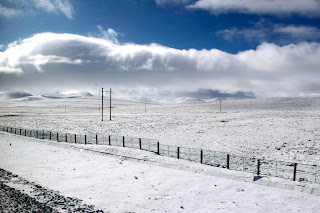Covering over 1,200 miles across the Tibetan Plateau, the Qinghai-Tibet Railway passes some of the most beautiful scenery in Asia.
From the windows of the train, it is possible to take in some of Tibet's most pristine vistas and natural wildlife as the train rolls across the highlands. In the summer, it is possible to see herds of yaks or, if you're lucky, Tibetan antelopes roaming. In the winter, there is a good chance you will roll through at least one blizzard along the way, the route rising as high as 16,640 ft. (5,068m) as it crosses the Tanggu Pass. A winter view from the window makes it easy to see why Tibet is called "the Land of Snows."
Embarking from Xining city in China's Qinghai province, the trip takes a total of 24 hours. The train starts out moving west past Qinghai Lake and further onto the town of Golmud before turning south, toward the Tanggu Mountains and Tibet.
 |
| Cuona Lake on the Qinghai-Tibet Railway |
Not long after crossing into the Tibet Autonomous Region, the train passes by Cuona Lake, the highest freshwater lake in the world. Don't miss the opportunity to grab a photo when the train stops briefly for passengers to disembark. Past Cuona Lake is the town of Nagqu, famous for its "wormgrass" herbal remedy and annual Tibetan horse racing festival, the largest of its kind.
 |
| Enjoy the view from your bunk |
- Seated tickets are padded seats around a shared table, 4 or 6 seats per table depending on the train car configuration. This is the lowest price option, and as such, will be more crowded and "rowdy" than either sleeper option. This is about as authentic a Chinese experience as you can get.
- Hard sleeper berths are "hostel-style" bunks, 6 per compartment with 3 bunks stacked on either side of the compartment. Each sleeper car has a walkway down one side of the car and sleeping compartments opening to the walkway, with no door to close them off from other passengers walking by (or smoking).
- Soft sleeper berths are the priciest and most exclusive, though the term is fairly relative. Each soft sleeper compartment has a door to close it off from the hall and only 4 beds per compartment, though there is still a good chance that your compartment-mates will smoke in the compartment, as smoking is allowed on all Chinese trains.
As with all train travel in China, boiling water is available in every train car and food carts will occasionally come through with drinks and refreshments, but it is usually a good idea to plan ahead and at least bring some snacks for the journey and a container that can be used to cool down boiling water.
One important final note - travel to Tibet requires special permitting, in addition to a Chinese tourist visa. Rail and air tickets to Tibet can only be purchased once the appropriate permits have been obtained, so it might be advisable to check with a reputable travel agency who can secure both the necessary permits and tickets, minimizing confusion and hassle. For suggestions of agencies, see Guides We Trust.


No comments:
Post a Comment